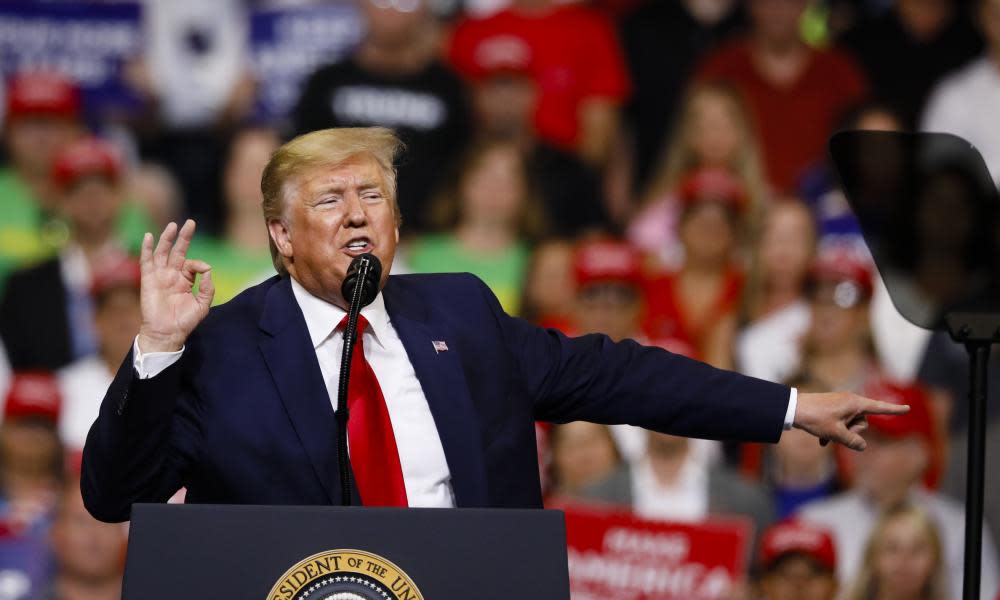Four reasons why Trump is cruising toward re-election

On Tuesday night Donald Trump launched his re-election campaign with a by now classic rally in Orlando, Florida. It was a “greatest hits rally” in which he accused the Democrats of undermining democracy (by trying to impeach him), talked about the many threats to “this country as we know it”, and even railed against Hillary Clinton (for old time’s sake). In short, Trump’s message for 2020 is: “I made America great again, now vote for me so I can Keep America Great.”
Democrats will dismiss the speech as lacking ideas and just fearmongering, while reveling in recent polls that have virtually every major primary candidate defeat Trump in 2020, sometimes by a significant margin. They believe the president is weakened by a broad range of issues, including the Mueller report, the treatment of immigrants at the southern border and the various scandals surrounding key cabinet members.
Remarkably, given the traumatic experience of 2016, many Democrats have still not learned the key lesson of US democracy: elections are not won by passive majorities but by mobilized minorities. And while the passive majority might be with the Democrats, or at least not with Trump, the mobilized minority is. There are (at least) four reasons why, at this moment, Trump is cruising towards re-election.
The first reason is, of course, the economy. While we can argue about how meaningful and solid the current economic growth is, there is no denying that, in terms of the conventional economic indicators, the state of the US economy is excellent. Consequently, prediction models based primarily on economic indicators, which correctly predicted the 2016 elections, predict a resounding Trump victory in 2020.
Second, Trump has so far delivered to his non-traditional base. The average Republican, commonly referred to as the “moderate Republican”, is still not a fan of Trump, who is seen as too confrontational and vulgar, but got the one thing they care about: a tax cut. Scared of a “socialist backlash” within the Democratic party, they will come out to protect their new gains by voting Trump.
Related: Why Bernie Sanders' radicalism can take out Trump | Nathan Robinson
Similarly, the Christian right will once again come out strong. While the support for Trump by religious voters puzzles liberals, it is pretty straightforward: the supreme court. Here, again, Trump has delivered. He has appointed two staunchly conservative anti-abortion judges to the supreme court, Neil Gorsuch and Brett Kavanaugh, and promised to appoint more. And with the possibility of (at least) one position possibly becoming vacant in the next presidential term, ie Ruth Bader Ginsburg (perhaps also Clarence Thomas), the Christian right mobilization will run on full cylinders again. The reward for the faithful: overturning Roe v Wade!
Finally, there is the real Trump supporter, the mostly blue-collar and lower-middle-class white voters who want to “build the wall” (nativism) and “drain the swamp” (populism). So far, they have not really gotten what they wanted. The swamp has barely been drained – rather, it has been expanded by corrupt Trump appointees – while, despite all of Trump’s grandstanding, the wall is still mostly a fence-in-building. In short, the real Trump voter is left wanting – as is at times loudly proclaimed by their media voices like Ann Coulter and Tucker Carlson. But where can they go? To the most diverse party in US history? The party of Bernie Sanders, Alexandria Ocasio-Cortez, Stacey Abrams and Elizabeth Warren?
Trump can rightly claim that he has done all he could to keep the wall on the political agenda and push through a brutal anti-immigration agenda
But maybe they will stay at home, disappointed? Not really. They have not been betrayed by Trump. He can rightly claim that he has done all he could to keep the wall on the political agenda and push through a brutal anti-immigration agenda. He will claim that he has been “sabotaged” by the “deep state” and their corrupt helpers in Congress (including “weak” Republicans). Hence, he needs a second term to break the last resistance so that can make good on his promises.
Third, against this mobilized minority stands a majority of Americans unhappy with Trump but largely uninspired by the Democratic party. They see a party without a clear profile, divided over more than 20 primary candidates, who differ on more than they agree on. Moreover, with still some 500 days to go until election day, Democrats are already turning against each other – with anti-Sanders donors trying to co-opt candidates, while Democratic insiders are feuding with the Sanders camp, which is fundraising against the Democratic establishment.
All of this is putty in the hands of the Trump campaign, the fourth reason the president is set for re-election. As should be clear by now, Trump actually ran a good campaign in 2016 – clearly much better than Clinton, who misread the rust belt states, among others. Trump has been running a “permanent presidential campaign” since his inauguration, which has picked up financial steam more recently. The campaign has been raking in money by the tens of millions, including from key Republican campaigners and donors who had spurned him in 2016.
Trump may be historically unpopular, but he is popular enough to be (comfortably) re-elected. His supporters have agency and urgency, the two things the Democrats are still lacking. They have 500 days left to create this, together, rather than apart.

 Yahoo News
Yahoo News 
